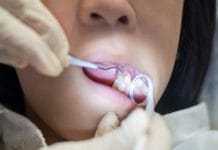Periodontal disease has been linked to a wide range of systemic diseases when left untreated. Researchers are working to prevent this by conducting several experiments to determine which home care aids dental professionals can recommend to help with healthier outcomes. An article, titled “Effect of two post‐surgical cleansing protocols on early periodontal wound healing and cytokine levels following osseous resective surgery: a randomized controlled study,” took a closer look at this particular problem. The article was published in the March edition of the International Journal of Dental Hygiene.
A Closer Look at Periodontal Diseases
There are two main types of periodontal disease: periodontitis and gingivitis. Periodontitis can affect the underlying soft tissue and bone surrounding the teeth. A patient with periodontitis can potentially lose their teeth if they don’t receive treatment. Meanwhile, gingivitis is a milder form of periodontal disease.
Both types of periodontal disease can quietly develop at a fast pace while the patient is completely unaware, especially if they do not keep regular dental appointments to monitor their oral health.
Periodontal disease can lead to the formation of deep periodontal pockets and harm the underlying alveolar bone over time. Dentists may perform osseous resective surgery in an effort to reduce the patient’s periodontal pockets. The therapy can usually correct the patient’s dental issues by either reshaping or removing different sections of the alveolar bone structure.
About the Scientific Study
A team of seven scientists decided to examine how patients healed after osseous resective surgery using two different post‐surgical cleansing protocols. To do this, they decided to compare the patient’s oral cytokine fluid levels. Cytokines are known for their ability to communicate with nearby cells. Scientists typically use them to measure and detect the progression of diseases.
For the study, the researchers worked with a group of 30 patients who had chronic periodontitis for 28 days. They randomly assigned the participants to different post‐surgical protocols after their osseous resective surgery that included a fiber retention technique. The control group was asked to wait two weeks after the surgery before they could clean their teeth with a manual toothbrush and mouth rinse that had 0.12% chlorhexidine inside. Meanwhile, the scientists asked the test group to use the same mouthwash and a sonic toothbrush starting immediately after the procedure.
The scientists reviewed the Interleukin (IL)‐1β and IL‐8 levels each week over 28 days when the patient’s come in for a clinical assessment. Based on the post-operative gingival crevicular fluid and the patient’s self-reported pain levels, the researchers were able to make several conclusions.
First, the test group was able to heal faster and experienced less plaque buildup and inflammation around their teeth. They also noticed that the dental wounds for the control group healed more slowly and they experienced more inflammation, although both groups reported similar levels of pain.
In Conclusion
This study demonstrates how great oral hygiene, including the use of a sonic toothbrush, immediately after surgery and beyond can help dental patients heal faster after surgery.











